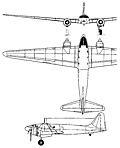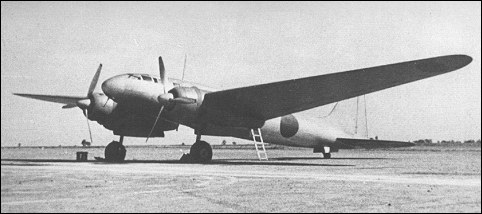|
| The A-26, later redesignated Ki-77, was a long-distance record aircraft with a remarkably slim fuselage and finely tapered wide-span monoplane wings. The first prototype flew on November 18, 1942. Two built.

| MODEL | Ki-77 |
| CREW | 5 |
| ENGINE | 2 x Nakajima Ha-115, 875kW |
| WEIGHTS |
| Take-off weight | 16725 kg | 36873 lb |
| Empty weight | 7237 kg | 15955 lb |
| DIMENSIONS |
| Wingspan | 29.44 m | 97 ft 7 in |
| Length | 15.3 m | 50 ft 2 in |
| Height | 3.85 m | 13 ft 8 in |
| Wing area | 79.56 m2 | 856.38 sq ft |
| PERFORMANCE |
| Max. speed | 440 km/h | 273 mph |
| Cruise speed | 300 km/h | 186 mph |
| Ceiling | 8700 m | 28550 ft |
| Range | 18000 km | 11185 miles |
 | A three-view drawing (752 x 930) |
| lxbfYeaa, e-mail, 14.03.2024 06:42 20 reply | | nana, 20.06.2011 13:34 I will have to go back and hunt down my source for ULTRA signal Holger. Most likely I read of it at Axishistoryforum website, but I will go back to sources. I genuinely can't recall at the moment. reply | | Mike Dunne, e-mail, 09.05.2011 16:20 Beautiful design! It set some notable long range records during the war. The old boy who designed it was a guest of Boeing when they introduced the Boeing 747SP into service..in recognition of his design work on the Ki 77 reply | | Ryu, e-mail, 11.03.2010 23:34 Could you let me know which archive or collection has the CX /MSS 2867 /T8 decrypt?
The crew and passengers on the 7 /7 /43 flight were as follows:
Asahi Newspaper staff:
Pilot: Juukou Nagatomo
Co-pilot: Hajime Kawasaki
Flight Engineer: Kenji Tsukagoshi
Flight Engineer: Noriyoshi Nagata
Radio Operator: Motohiko Kawashima
Army:
Lieutenant-Colonel Shozou Nakamura (Commandin officer for the flight, IJA expert on radio navigation, previously stationed in Germany)
Colonel Yoshiaki Nishi (former military attache to Madrid)
Lieutenant-Colonel@Takasuke Katori (due to take post as assistant to the military attache in Berlin). reply | |
| | Simon Gunson, e-mail, 10.04.2009 00:05 Hello Holger,
Yes your grandfather's unit was primarily involved with airfield construction around the Crimea and by 1943 it comprised 5 companies with an attached Koflug air traffic control unit Lw.-Bau-Geräte-Zug 2. This Luftgau Kommando Flughafenbereich was an airport area command unit. It may not have had it's own flak units, but it would have controlled flak batteries of surrounding units.
In his book "Russia and the West" STEPHEN D. KERTESZ alerts me that in June 1943 Molotov flew to Sarabus for secret peace talks with the Germans. It is highly likely therefore that Tachikawa Ki-77 flight was involved with transporting a Japanese peace legation to Sarabus for further talks. Prince Konoye was involved in creating Peace talks between Hitler and Stalin in 1943.
I will have to go back and hunt down my source for ULTRA signal Holger. Most likely I read of it at Axishistoryforum website, but I will go back to sources. I genuinely can't recall at the moment. reply | | Holger, e-mail, 06.04.2009 17:04 Hi Simon!
Could you let me know your source for the "Enigma signal sent to Lw.-Bau-Btl. 16 /XI warning that unit to stand down it's Flak batteries"?
My Grandfather was a member of that unit the whole time (09 /39-01 /45) and this is the firt hint I've ever found, that the unit did not do construction works only but seem to have Flak batteries (or at least used them).
Kind regards,
Holger reply | | Simon Gunson, e-mail, 31.12.2008 23:11 This aircraft was intended to fly a non-stop mission from Singapore to Sarabus airfield in the Crimea on 7 July 1943. A reception committee from Luftwaffe high command arrived at Sarabus to greet it including Karl Gartenfeld, Horst Gotz, and Wolfgang Nebel who disembarked Ju-290 T9+FK. The British however read an Enigma signal sent to Lw.-Bau-Btl. 16 /XI warning that unit to stand down it's Flak batteries.
The following ULTRA signal from Berlin dated 7 July 1943 was sent to Kdo.d.Flughafenbereich 6 /VI (Airfield Regional Command) at Sarabus, Crimea :
"On 8 /7 an allied aircraft will fly via air grid squares 3420, 2560 and 2510 to Sarabus. It is a two engined low wing monoplane, wing span 30 metres, metal fuselage, natural colour, wings grey. The aircraft must not be fired on under any circumstances."
The ULTRA signals intelligence analyst at Blechley Park then appended the following note: "This presumably refers to undertaking "GOA" in which an aircraft was flying to Sarabus from Tokio via Singapore." (ULTRA signal CX /MSS 2867 /T8). The British clearly expected "GOA" undertaking and set out to intercept the aircraft over the Indian Ocean, where the Ki-77 was thought to have disappeared. reply |
|
Do you have any comments?
|
| 
COMPANY
PROFILE
All the World's Rotorcraft
|








